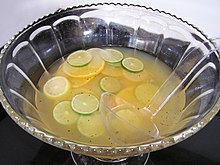Punch bowl

A punch bowl is a bowl, often large and wide, in which the drink punch is served.[2]
Origins
The word punch is a loanword from Hindi. The original drink was named paantsch, which is Hindi for "five", and the drink was made from five different ingredients: spirit, sugar, lemon, water or tea and spices. The drink was brought back from India to England by the sailors and employees of the British East India Company in the early seventeenth century, and from there it was introduced into other European countries.[2]
Punch bowls

Punch quickly became a popular drink. It was served in punch bowls, usually ceramic or silver, which were often elaborately decorated. Punch bowls sometimes had lids or were supported on a stand; other accessories such as a serving ladle and cups in which to serve the drink sometimes accompanied the punch bowl. Punch bowls were often painted with inscriptions or were used for testimonial purposes: the first successful whaling voyage from Liverpool was commemorated by a punch bowl presented by the owners of the ship to its captain.[3]
The ubiquity of the punch bowl as a household item is illustrated in this 1832 quote:
The punch-bowl was an indespensible vessel in every house above the humblest class. And there were many kindly recollections connected with it, it being very frequently given as a present. No young married couple ever thought of buying a punch-bowl; it was always presented to them by a near-relative.[3]

Occasionally less likely vessels were used as punch bowls:
On the 15th October 1694 Admiral Edward Russell, then commanding the Mediterranean fleet, gave a grand entertainment at Alicante. The tables were laid under the shade of orange-trees, in four garden-walks meeting in a common centre, at a marble fountain, which last, for the occasion, was converted into a Titanic punch-bowl. Four hogsheads of brandy, one pipe of Malaga wine, twenty gallons of lime-juice, twenty-five hundred lemons, thirteen hundredweight of fine white sugar, five pounds' weight of grated nutmegs, three hundred toasted biscuits, and eight hogsheads of water, formed the ingredients of this monster-brewage. An elegant canopy placed over the potent liquor, prevented waste by evaporation, or dilution by rain; while, in a boat, built expressly for the purpose, a ship-boy rowed round the fountain, to assist in filling cups for the six thousand persons who partook of it.[3]
Particular punch bowls

- Jesus College, Oxford owns a large silver-gilt punch bowl, presented by Sir Watkin Williams-Wynn in 1732.[4] The bowl, which weighs more than 200 ounces (5.7 kg) and holds 10 imperial gallons (45 L), was used at a dinner held in the Radcliffe Camera in 1814, to celebrate what was supposed to be the final defeat of Napoleon. Those present at the dinner included the Tsar of Russia, the King of Prussia, Blücher, Metternich, the Prince Regent, the Duke of York and the Duke of Wellington.[5] There is a college tradition that the bowl will be presented to anyone who can meet two challenges. The first is to put arms around the bowl at its widest point; the second is to drain the bowl of strong punch. The bowl measures 5 feet 2 inches (1.57 m) at its widest point, and so the first challenge has only been accomplished rarely; the second challenge has not been met.[6]
- The Stanley Cup is frequently described as a punch bowl.
- The Sydney punchbowls are made of Chinese porcelain and depict rare scenes of early Sydney.
- The Liscum Bowl set is made from 90 pounds (41 kg) of sterling silver gifted to the United States Army from China during the Boxer Rebellion in 1900. It is the most prized possession of the 9th Infantry Regiment and worth upwards of $2.5 million.[7]
Other uses
At times, punch bowls were used as baptismal fonts in dissenting families.[3]
The American poet Oliver Wendell Holmes wrote the poem On Lending a Punch-bowl about an old silver punch bowl.[8]
In English usage, large, bowl-shaped landscape features (often the head of combes or valleys) were occasionally given the name punch bowl, such as the Devil's Punch Bowl in Surrey or Punchbowl Crater ("The Punchbowl") on the island of Oahu in Hawaii.
References
- ^ "Punch bowl and Stand". Metalwork. Victoria and Albert Museum.
{{cite web}}: Missing or empty|url=(help) - ^ a b The Language of Drink Graham and Sue Edwards 1988, Alan Sutton Publishing
- ^ a b c d Chambers, Robert (1832). Punch and Punch-bowls in The Book of Days. London, UK: W. & R. Chambers Ltd. pp. 496–9. Retrieved 29 October 2008.
punch bowl.
- ^ Glanville, Philippa (2004). "A Treasured Inheritance". Oxford Today. 16 (3). Oxford University Public Affairs Directorate. Archived from the original on 26 December 2005. Retrieved 15 March 2007.
- ^ Popkin, Michael (November 2001). "War and Peace". Oxford Inscriptions: Inscribed Stones and Plaques in Oxford. Archived from the original on 15 March 2007. Retrieved 15 March 2007.
- ^ Thomas, Llewellyn (1891). "Jesus College". In Clark, Andrew (ed.). The colleges of Oxford: their history and traditions. London: Methuen & Co. p. 387. Retrieved 19 August 2008.
- ^ Robson, Seth (28 December 2003). "2nd ID museum director keeps history alive". Stars and Stripes. Retrieved 25 November 2016.
- ^ Holmes, Oliver Wendell (1852). The Poetical Works of Oliver Wendell Holmes. London, UK: G. Routledge & Co. pp. 267–71. ISBN 9781421916804.
punch bowl oliver.
